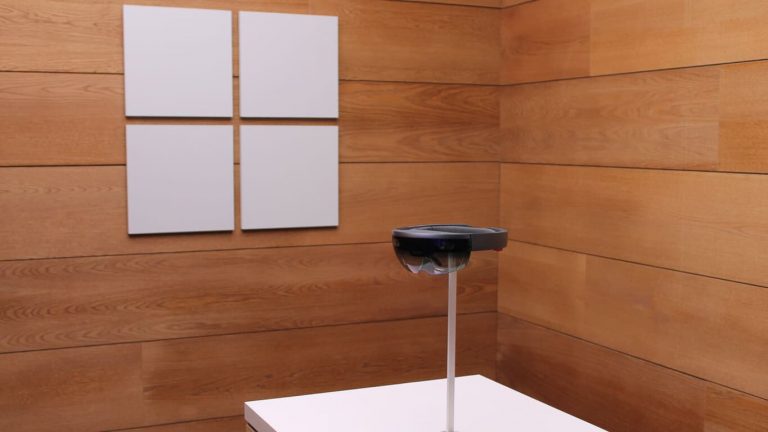At its October 6th event in New York City, Microsoft made a number of announcements, including that it will be releasing a HoloLens Developer Edition, shipping in the first quarter of 2016 and costing $3000. At the same time, Microsoft announced a series of HoloLens developer demos, in 11 cities across the US, where the company is showing off the device and making team members available for questions.
Those events booked solid in less than two hours, and although I only got my name on a waiting list (if you’re in one of the upcoming cities, you might try registering and getting on a waiting list), I was able to get in on a session held at Seattle’s Hotel Max event space, a typically funky Seattle venue in a room above their parking garage. (Pic credit thanks to Rafael Rivera, who posted this somewhat cryptic pic on Twitter, and went to the same event on Wednesday):
Sessions were set up for three attendees at a time, each with their own “room”, and a half hour or so for each session, so while the space was never crowded, a steady stream of developers and interested parties was filing up the stairs.
After a quick overview demo and a chance to practice our “tap” gesture, we were each led into a mockup of a living room, and fitted with a HoloLens.
The devices, promoted as “developer prototypes”, were similar or the same to the ones we used at Build, and the ones you’ve seen countless pictures of. As usual, we weren’t allowed to take pictures, but security at this event was much more lax than at previous sessions, and I wasn’t required to lock my cellphone in a locker.
The experience was fun. This time we played X Ray, the game they demoed at the October 6th event. It featured scorpion-like “aliens” busting through walls, and by using HoloLens concepts like gaze, gesture, and voice, we were able to shoot the aliens down and control them with our special voiced “X Ray” commands.
https://www.youtube.com/watch?v=L3q8KVsVdIc
The HoloLens worked much the same as it did at Build, with a constrained field of view, but also a vibrant, fast, fluid experience. I found myself, while trying to dodge alien blasts, bringing my gesture finger out of the field of the HoloLen’s vision, and had to remember to hold my hand where it could see the gestures.
I also noticed that more than the field of view itself, keeping the HoloLens experience centered was a bit of an issue. Because the HoloLens experience takes place directly in front of you, and you quickly become immersed in this new augmented world, there was a tendency to look around with my eyes instead of move my head, and the HoloLens along with it, toward whatever new subject (in this case, invading aliens) I needed to pay attention to.
The HoloLens worked well when you centered your vision by looking straight ahead and moving the device along with you, but the narrow field of view quickly became an issue as you moved your eyes out of that FOV, a natural inclination that might be hard to overcome.
Still, the experience IS immersive, although not completely so, and the visual effects of computer generated objects or beings adhering to the contours of the room and interacting with them are simply stunning.
After our session fighting aliens and defending our “living rooms”, we had a chance to meet with some Microsoft HoloLens developers who walked us through a high level overview of the development structure, and answered some questions.
[pullquote align=”full” cite=”” link=”” color=”” class=”” size=””]”writing code for the HoloLens was just like writing code for Windows, because in essence it IS Windows”[/pullquote]
Although this was a developer event, we weren’t showed any code, but the Microsoft devs onhand emphasized that writing code for the HoloLens was just like writing code for Windows, because in essence it IS Windows. HoloLens runs Windows 10, albeit with a special Holographic Processing Unit, and the Unity graphics engine controls all the heavy graphics and physics lifting. Microsoft is working closely with Unity, and a special new version of the software will enable HoloLens development once the SDK lands.
Of course I asked some admittedly unanswerable questions about consumer availability and the like, but although they wouldn’t specifically answer questions about broader availability of the devices, they called the release of the Developer Edition a “significant milestone”, and likened it to the release of the Xbox One developer kit (where consumer units became available shortly after the developer kits were issued).
Microsoft is gearing up the process: opening up to more developers, gauging interest, and coming closer to some sort of initial public release. Will we all see a HoloLens under our Christmas trees next holiday season? That may be doubtful, but a limited commercial release sometime next year seems doable. If you’re chomping at the bit to try out the HoloLens, you might not have much longer to wait.





